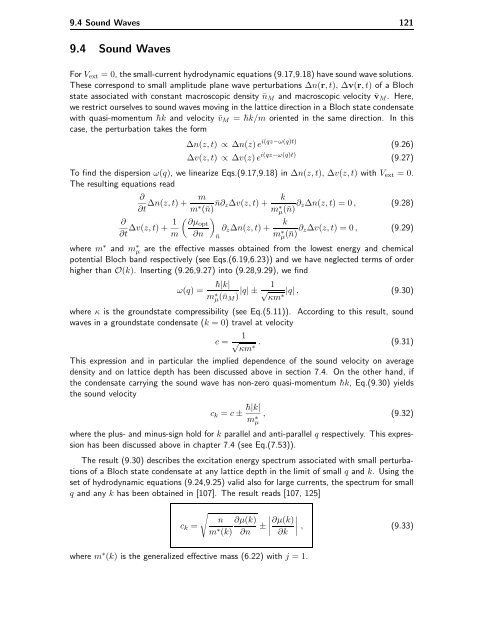Bose-Einstein Condensates in Rotating Traps and Optical ... - BEC
Bose-Einstein Condensates in Rotating Traps and Optical ... - BEC
Bose-Einstein Condensates in Rotating Traps and Optical ... - BEC
Create successful ePaper yourself
Turn your PDF publications into a flip-book with our unique Google optimized e-Paper software.
9.4 Sound Waves 121<br />
9.4 Sound Waves<br />
For Vext =0, the small-current hydrodynamic equations (9.17,9.18) have sound wave solutions.<br />
These correspond to small amplitude plane wave perturbations ∆n(r,t), ∆v(r,t) of a Bloch<br />
state associated with constant macroscopic density ¯nM <strong>and</strong> macroscopic velocity ¯vM. Here,<br />
we restrict ourselves to sound waves mov<strong>in</strong>g <strong>in</strong> the lattice direction <strong>in</strong> a Bloch state condensate<br />
with quasi-momentum ¯hk <strong>and</strong> velocity ¯vM =¯hk/m oriented <strong>in</strong> the same direction. In this<br />
case, the perturbation takes the form<br />
∆n(z,t) ∝ ∆n(z) e i(qz−ω(q)t)<br />
(9.26)<br />
∆v(z,t) ∝ ∆v(z) e i(qz−ω(q)t)<br />
(9.27)<br />
To f<strong>in</strong>d the dispersion ω(q), we l<strong>in</strong>earize Eqs.(9.17,9.18) <strong>in</strong> ∆n(z,t), ∆v(z,t) with Vext =0.<br />
The result<strong>in</strong>g equations read<br />
∂<br />
m<br />
∆n(z,t)+<br />
∂t m∗ k<br />
¯n∂z∆v(z,t)+<br />
(¯n) m∗ µ(¯n) ∂z∆n(z,t) =0, (9.28)<br />
<br />
∂<br />
1 ∂µopt<br />
∆v(z,t)+ ∂z∆n(z,t)+<br />
∂t m ∂n ¯n<br />
k<br />
m∗ µ(¯n) ∂z∆v(z,t) =0, (9.29)<br />
where m∗ <strong>and</strong> m∗ µ are the effective masses obta<strong>in</strong>ed from the lowest energy <strong>and</strong> chemical<br />
potential Bloch b<strong>and</strong> respectively (see Eqs.(6.19,6.23)) <strong>and</strong> we have neglected terms of order<br />
higher than O(k). Insert<strong>in</strong>g (9.26,9.27) <strong>in</strong>to (9.28,9.29), we f<strong>in</strong>d<br />
ω(q) = ¯h|k|<br />
m∗ 1<br />
|q|± √ |q| , (9.30)<br />
µ(¯nM) κm∗ where κ is the groundstate compressibility (see Eq.(5.11)). Accord<strong>in</strong>g to this result, sound<br />
waves <strong>in</strong> a groundstate condensate (k =0)travelatvelocity<br />
c = 1<br />
√ . (9.31)<br />
κm∗ This expression <strong>and</strong> <strong>in</strong> particular the implied dependence of the sound velocity on average<br />
density <strong>and</strong> on lattice depth has been discussed above <strong>in</strong> section 7.4. On the other h<strong>and</strong>, if<br />
the condensate carry<strong>in</strong>g the sound wave has non-zero quasi-momentum ¯hk, Eq.(9.30) yields<br />
the sound velocity<br />
ck = c ± ¯h|k|<br />
m ∗ µ<br />
, (9.32)<br />
where the plus- <strong>and</strong> m<strong>in</strong>us-sign hold for k parallel <strong>and</strong> anti-parallel q respectively. This expression<br />
has been discussed above <strong>in</strong> chapter 7.4 (see Eq.(7.53)).<br />
The result (9.30) describes the excitation energy spectrum associated with small perturbations<br />
of a Bloch state condensate at any lattice depth <strong>in</strong> the limit of small q <strong>and</strong> k. Us<strong>in</strong>g the<br />
set of hydrodynamic equations (9.24,9.25) valid also for large currents, the spectrum for small<br />
q <strong>and</strong> any k has been obta<strong>in</strong>ed <strong>in</strong> [107]. The result reads [107, 125]<br />
<br />
n<br />
ck =<br />
m∗ ∂µ(k)<br />
(k) ∂n ±<br />
<br />
<br />
<br />
∂µ(k) <br />
<br />
∂k , (9.33)<br />
where m ∗ (k) is the generalized effective mass (6.22) with j =1.




